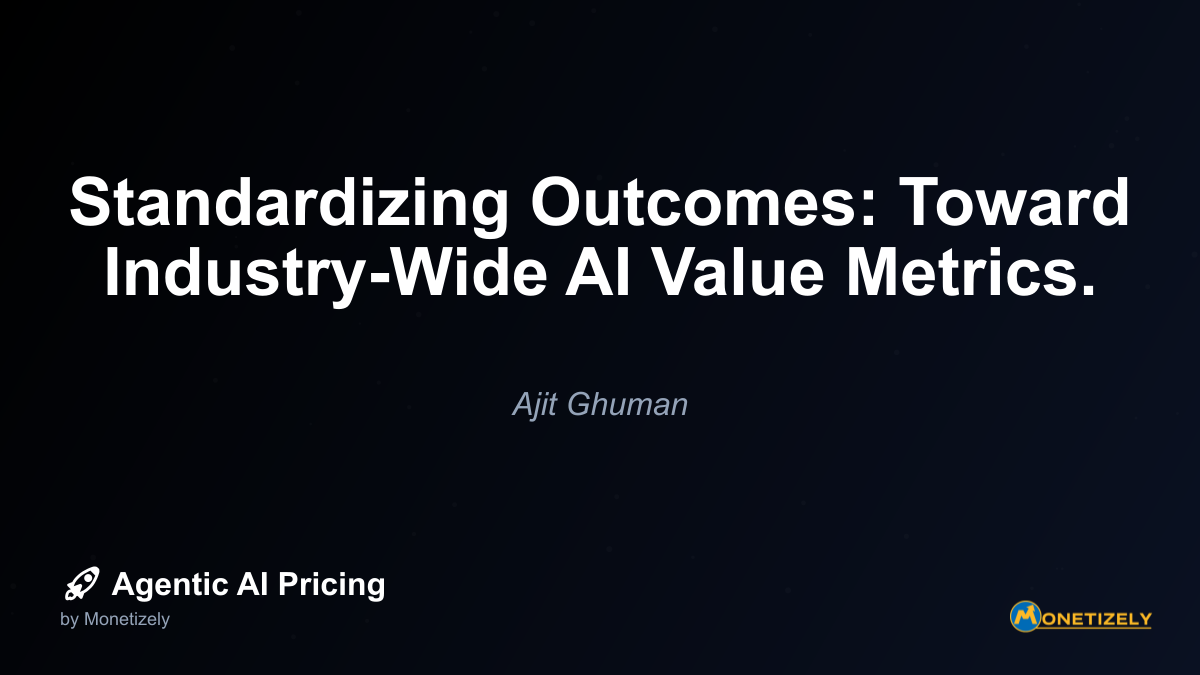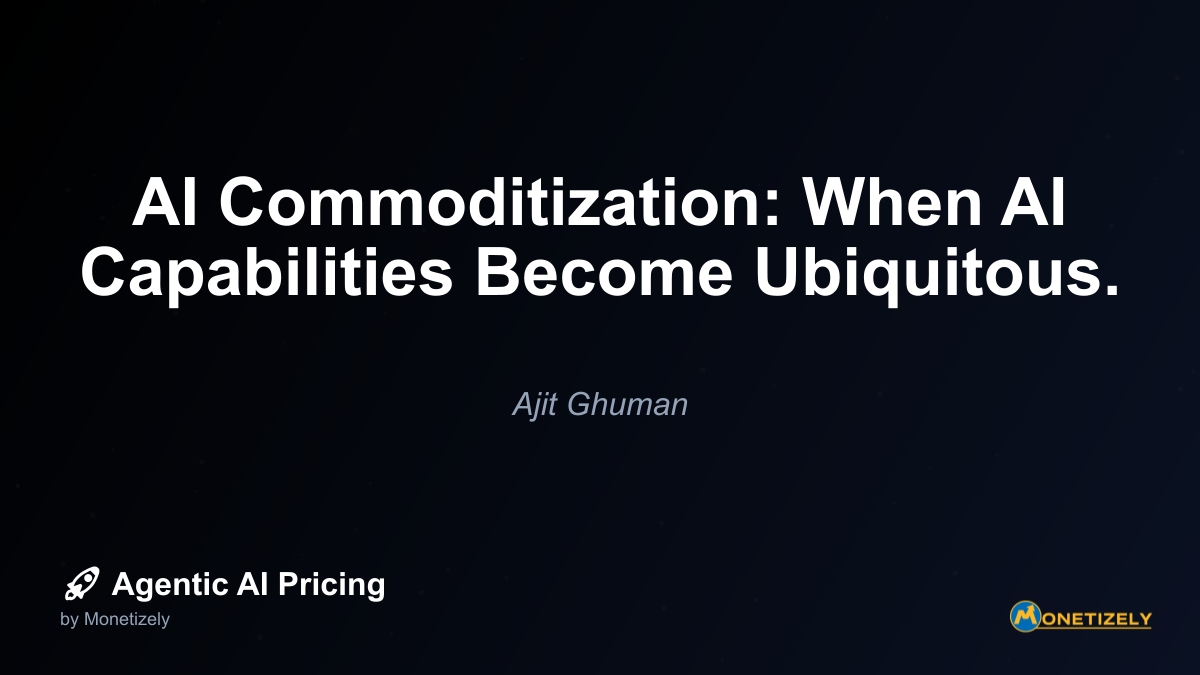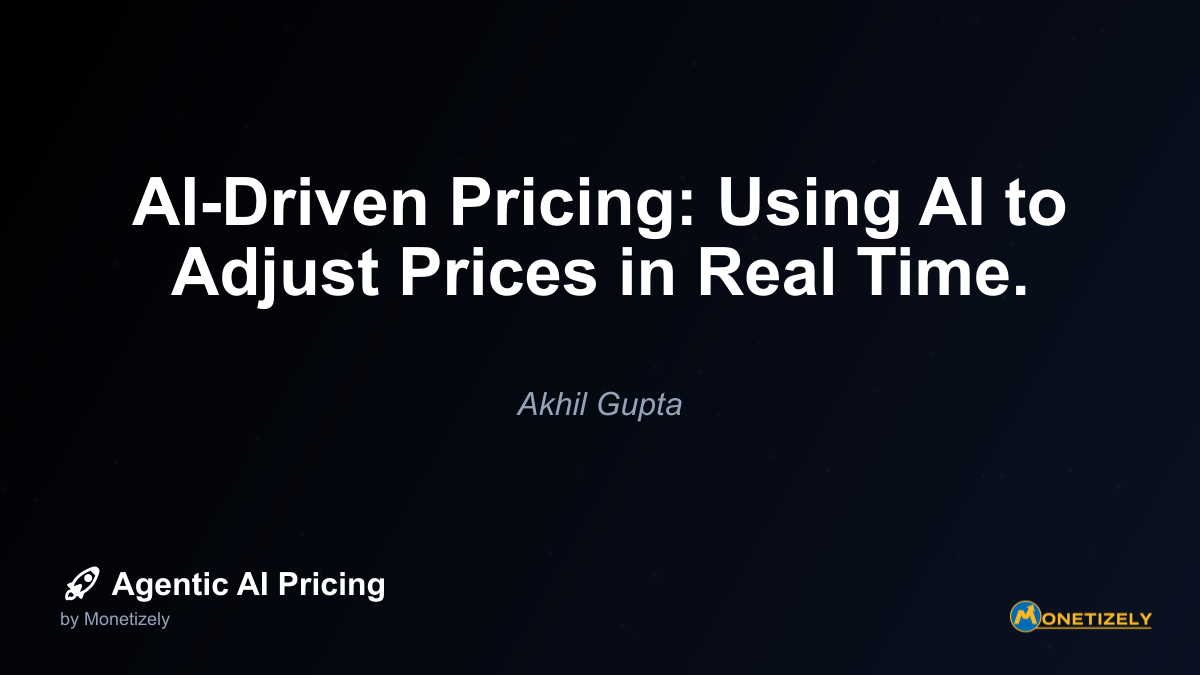· Ajit Ghuman · Emerging Trends · 5 min read
Standardizing Outcomes: Toward Industry-Wide AI Value Metrics.
AI and SaaS Pricing Masterclass
Learn the art of strategic pricing directly from industry experts. Our comprehensive course provides frameworks and methodologies for optimizing your pricing strategy in the evolving AI landscape. Earn a professional certification that can be imported directly to your LinkedIn profile.

Implementing Standardized Metrics in Your Organization
For organizations looking to prepare for and benefit from the trend toward standardized AI outcome metrics, several practical steps can be taken:
Audit Current Measurement Practices
Begin by understanding your current approach:
- Document existing metrics: Catalog how you currently measure AI performance across different applications.
- Identify inconsistencies: Note where different departments or vendors use conflicting definitions.
- Assess measurement gaps: Determine where you lack clear metrics altogether.
Engage with Industry Initiatives
Participation in standardization efforts provides both influence and early insight:
- Join relevant consortia: Become a member of industry groups working on metric standardization.
- Contribute to standards development: Share your organization’s expertise and requirements.
- Monitor emerging standards: Stay informed about developments even if not actively participating.
Align Vendor Relationships
Prepare your vendor ecosystem for standardization:
- Include standardization clauses: Add language to contracts that anticipates adoption of industry standards.
- Request metric mapping: Ask vendors to map their proprietary metrics to emerging industry standards.
- Prioritize standards-compatible vendors: Consider standardization support in procurement decisions.
How Standardized Metrics Will Transform AI Pricing Models
As standardized metrics gain adoption, expect significant evolution in AI pricing models:
Rise of Pure Outcome-Based Models
Truly performance-based pricing becomes more feasible:
- Pay-per-resolution models: Customer service AI priced solely on successfully resolved tickets.
- Success fee structures: Marketing AI compensated based on qualified leads generated.
- Performance guarantees: Vendors offering refunds when standardized benchmarks aren’t met.
A healthcare AI vendor recently introduced a radiology diagnostic solution with pricing tied directly to accuracy rates as defined by the newly established Healthcare AI Consortium standards—charging only when diagnoses meet the standardized accuracy thresholds.
Hybrid Model Refinement
Most organizations will adopt hybrid pricing approaches:
- Base-plus-performance: Combining subscription fees with outcome-based components using standardized metrics.
- Tiered outcome pricing: Different price points based on performance thresholds against industry benchmarks.
- Risk-sharing arrangements: Vendors and customers sharing both upside and downside based on standardized performance measurements.
Market Evolution
The broader market will transform in several ways:
- Pricing transparency: Expect more open discussion of price-to-performance ratios.
- Performance marketplaces: Platforms that compare solutions based on standardized metrics may emerge.
- Industry benchmarking services: Third-party services validating performance claims against standards.
The Role of Standardization in AI Ethics and Governance
Standardized outcome metrics also intersect with growing concerns about AI ethics and governance:
Fairness and Bias Measurement
Standard metrics can incorporate fairness considerations:
- Demographic parity measures: Standards can require reporting performance across different user groups.
- Bias detection requirements: Standardized approaches to measuring and mitigating algorithmic bias.
- Inclusivity benchmarks: Metrics that evaluate AI performance across diverse user populations.
Transparency Requirements
Standards can promote greater transparency:
- Explainability metrics: Standard measures of how well AI systems can explain their decisions.
- Confidence scoring: Unified approaches to communicating AI confidence levels.
- Limitation disclosure: Common frameworks for disclosing known limitations and edge cases.
Compliance Integration
Standardized metrics can align with regulatory requirements:
- Regulatory-ready reporting: Metrics designed to satisfy emerging AI regulations.
- Audit compatibility: Standardized measurements that simplify compliance verification.
- Cross-border harmonization: Metrics that work across different regulatory regimes.
Looking Ahead: The Future of Standardized AI Metrics
The movement toward standardized AI outcome metrics is still in its early stages, but several trends suggest where it’s heading:
Vertical-Specific Standards First
Expect the most rapid progress in industry-specific metrics:
- Domain expertise advantage: Industries with established measurement traditions will move faster.
- Competitive pressure factors: Sectors with intense AI adoption will prioritize standardization.
- Regulatory influence: Industries with strong regulatory oversight may see standards emerge from compliance requirements.
Cross-Industry Harmonization Later
Eventually, cross-sector alignment will develop:
- Common foundational metrics: Basic measures like accuracy and reliability will harmonize across industries.
- Methodology standardization: Measurement approaches will become more consistent even when specific metrics differ.
- Interoperability standards: Frameworks allowing metrics to translate between different industry contexts.
From Measurement to Certification
The ultimate evolution may be formal certification programs:
- Third-party verification: Independent bodies validating performance against standards.
- Certification tiers: Formal recognition of different performance levels.
- Consumer-facing labels: Simplified indicators communicating standardized performance to end-users.
Conclusion: Preparing for the Standardized Future
The trend toward standardized AI outcome metrics represents a significant maturation of the AI marketplace. As industries develop common definitions for what constitutes success, organizations will benefit from greater transparency, simplified contracting, and more rational pricing models.
For AI vendors, this trend necessitates preparation for a more transparent competitive landscape where performance claims face greater scrutiny against industry benchmarks. For AI purchasers, it promises easier comparison shopping and more confidence in outcome-based pricing arrangements.
Organizations should consider taking several actions now to prepare for this shift:
- Inventory your AI applications and current measurement approaches
- Engage with industry standardization efforts relevant to your sector
- Begin conversations with vendors about metric standardization
- Consider standardization compatibility in new AI procurement
- Develop internal expertise in AI performance measurement
The organizations that embrace standardized metrics early stand to gain significant advantages—reducing procurement complexity, improving vendor management, and ultimately extracting greater value from their AI investments through more aligned incentives and clearer performance expectations.
As one AI pricing strategist recently observed, “Standardized metrics won’t just change how we measure AI success—they’ll fundamentally transform how we buy, sell, and price artificial intelligence. The companies that understand this shift early will have a significant competitive advantage.”
The path to standardization won’t be without challenges, but the direction is clear: the future of AI pricing will be built on a foundation of common, transparent metrics that finally allow the market to properly value the outcomes these powerful technologies deliver.
Co-Founder & CEO
Ajit is the author of Price To Scale, a top book on SaaS Pricing and is the Founder of Monetizely. Ajit has led and worked in pricing and product marketing at firms like Twilio, Narvar and Medallia. His work has been featured in Forbes and VentureBeat. Ajit regularly consults with software companies from Seed stage to post-IPO on pricing strategy. Ajit is also a highly-rated co-instructor for 'The Art of SaaS Pricing and Monetization' on Maven.
Pricing Strategy Audit
Let our experts analyze your current pricing strategy and identify opportunities for improvement. Our data-driven assessment will help you unlock untapped revenue potential and optimize your AI pricing approach.




